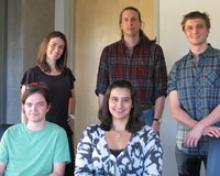 The undergraduate students in Professor Linda Hirst’s new internship course are getting an advanced education in science communications that could serve them well in their future careers.
The undergraduate students in Professor Linda Hirst’s new internship course are getting an advanced education in science communications that could serve them well in their future careers.
By condensing the latest scientific papers for Hirst’s Soft Matter World website, Science Writing interns Amanda Baijnauth and Michael Lane are not only learning more about soft-matter science, they are getting an education in communicating complex information to a wider audience, meeting deadlines and time management.
The internship involves the two students, Hirst, Paul Gibbons, assistant director of UC Merced’s Merritt Writing Program, and Adam Ossowski, who has worked on the website and newsletter since they began. Each student is given a different scientific paper to work on, and within three weeks, must have a one-page summary worthy of inclusion on Hirst’s site.
That means the writing of UC Merced students is reaching softmatterworld.org’s 400 scientist members worldwide, including Israel, Greece, Italy, Poland, the U.K., the Netherlands and across the United States.
“It’s enjoyable and it’s important,” said Lane, who changed his major from chemistry to anthropology so he could do more archaeology in the field than in the lab. “Even though chemistry is more of a hard science, this has helped me write for other classes, too.”
By the end of the semester, each student will have written four summaries, enhancing their professional journal experience.
Hirst founded softmatterworld.org in 2008 with the goal of becoming a hub for the soft-matter research community, providing a place for further education and networking.
Soft matter physics, chemistry and materials science covers everything from liquid crystals, polymers and gels to biomolecular assembly and the interface between hard and soft condensed matter, according to the website.
This year, Hirst decided to give students the opportunity to be published and communicate with the larger scientific community. She asked Gibbons to recommend students who had writing skills and could handle the scientific work.
“I was really excited that a faculty member recommended me, and another faculty member took an interest in me,” Baijnauth said. “That really means a lot.”
But it’s not easy.
“We’re training them to review papers and communicate science to people who don’t know much about each subject,” Hirst said.
The internship seems to be working for everyone involved.
“It has been, by far, the best improvement on the website in a long time,” Ossowski said. “You can see that the students are really reading and understanding these papers.”
The students have to educate themselves on the subject of each paper they are reviewing, and Lane said sometimes that means extra research and studies.
The students have to verify their conclusions with Hirst, who goes through the science with them, and then be able to explain the science to Gibbons, who reviews each of their summaries and questions them about their subjects and writing choices.
“I teach science writing, but I don’t teach science,” Gibbons said, “so the students have to be able to teach me the science.”
Then the papers must be reviewed by Hirst, who makes the final decision on whether they are published. For example, Lane’s piece in the October Soft Matter World newsletter was about highly stretchable and tough hydrogels, while Baijnauth explained a paper about the mechanism of cucumber tendrils and how they over-wind.
Baijnauth, a senior microbiology major, said before the internship, most of her experience was in biology, and this experience has helped her grow.
“It has helped me expand as a student and as a person, to have a broader base of knowledge,” she said. “I might never have read most of these articles if it weren’t for the internship.”
Hirst, an expert in liquid crystals and biological matter, is no stranger to scientific communication. In addition to writing for her website, she has also just published a textbook entitled “Fundamentals of Soft-Matter Science,” scheduled for November release.
She and Gibbons intend to continue the Science Writing internship next semester, and could add more students, too.
“They are just going to get better and better at it,” Hirst said of her student writers. They are learning some of the finer points of professional communication, she said, including how to correspond with other professionals and how to give credit properly on scientific papers. They have to be organized and able to manage their time, and they are learning how to work on a newsletter, too, communicating with their editors and the website and letter designer.
Hirst hopes softmatterworld.org and the involvement of students will help UC Merced become a focal point for the soft-matter research world. There are other major centers in Colorado, Ohio and Pennsylvania, but “we want this to be the center for soft-matter research on the West Coast.”
Media Contact



